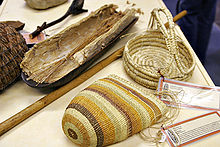Aboriginal handicrafts
The crafts Aboriginal takes up a considerable portion of the life contents of traditional Aboriginal one. These items are an essential part of the tourist trade. In contrast to the art of the Aborigines , these gestures have a craftsmanship value and do not reach the level of art objects.
Fiber weaving
Traditional Aboriginal weaving uses different types of fibers depending on geographical and ethnic origin.
Baskets were often made from the intertwined fibers of tree bark in all parts of the continent. This technique is used today to manufacture baskets for the souvenir industry. Kurrajong bark is popular, as are river wattle , sand fig , banyan fig , burney wine, and peanut tree . In the north the style is more closely woven, in the south bags like the Dilly bag are loosely woven .
Hair braid
Strings made from hair were common textiles traditionally made by Aboriginal people. Women in particular regularly cut their hair with knives made of quartz or flint. The hair was spun into long threads on spindles that were rolled on the thigh and then braided into cords. From this z. For example, rings were made that were worn on the head in order to place a coolamon (a vessel) on it, ribbons to keep the hair out of the face, with spears the point was tied to the shaft and balls to play with. A multi-purpose belt was made to which something could be hung: for example small game such as lizards , to keep your hands free on long hikes and when hunting.
In some groups such as the Pitjantjatjara a small apron was made for young girls in puberty to cover their pubes. To this day, people in Central Australia talk about a girl's string being broken, which can mean sexual abuse or premarital sex.
In some Aboriginal peoples , adults also wore loincloth- like clothing that hung from their belts. This was either made of thread or of other material such as paper-thin tree bark. In the Kimberleys the men wore rijis , which are covers made of mother-of-pearl that are considered very sacred. Some textiles were only worn at ceremonies, such as women's skirts.
The threads were dyed in different colors, for example with ocher .
Hair and grass braid
Grasses were processed with hair to make stronger fibers. Spinifex was used for this in arid areas , while palm trees such as pandanus were used at the top end . Pandanus and sand palm were used in the Daly River region and Arnhem Land to make carry baskets, murals, floor mats, and fishing nets.
pottery
In Australian Aboriginal culture there is no tradition of pottery, and so have only since the 1960s in Australia potteries established. One of the most famous is in Hermannsburg . It is a high level of craftsmanship made by Aboriginal women whose products are in demand in Australia and abroad. In their style, they mostly model everyday objects such as pots decorated with animal sculptures, which they set in color and then burn.
Didgeridoo
A few examples of the didgeridoos , an Aboriginal wind instrument, are lavishly painted for special ceremonial functions. This type of painting is now mostly made especially for tourist sales and it has become known that there are offers of these instruments in tourist shops, which were rarely made by Aborigines. In February 2007, Territory Art Minister Marion Scrymgour reported that backpackers were in part the makers of Aboriginal handicrafts. These were mainly handicraft products that were sold in tourist shops in Australia, and particularly extreme abuse was found in the industrial manufacture of didgeridoos and the painting by backpackers.
Handicrafts and counterfeits
In March 2006, ABC reported on the arts and crafts scams in Western Australia. Allegations have been made of poor working conditions, fake English backpackers' work, inflated prices, and artists posing with artwork for photographs that are not their own. In August 2006 the Australian Senate started an investigation. The investigation ran for 10 months and gathered evidence from all parts of Australia, with public hearings also held in Western Australia, Northern Territory, Sydney and Canberra.
When the final report was published in February 2007, it became known that some of the manufacturers of handicrafts that were declared as Aboriginal handicrafts were backpackers. Most of the didgeridoos were manufactured industrially and painted by tourists.
As a result, the Senate issued 29 recommendations on June 21, 2007, among others
- general public funding into the infrastructure of the sector
- stronger police controls to reduce unethical business practices
- Introduction of a code of practice in this sector
- Government agencies are implementing a process on how to deal with indigenous art
The report suggested that legal action be taken if the grievances are not corrected.
Web links
- Australian Aboriginal Anthropology
- Arrernte Dictionary
- Aboriginal Art Circular
- Alice Nampitjimpa artwork
- Man making hair band
Individual evidence
- ^ ABC Radio National interview with anthropologist Diane Bell
- ↑ Aboriginal Lonka Lonka Pearl Shell from the Kimberlys (Tribalmania.Com) ( Memento of the original from October 6, 2007 in the Internet Archive ) Info: The archive link was inserted automatically and has not yet been checked. Please check the original and archive link according to the instructions and then remove this notice.
- ↑ Archived copy ( memento of the original from November 21, 2008 in the Internet Archive ) Info: The archive link was inserted automatically and has not yet been checked. Please check the original and archive link according to the instructions and then remove this notice. www.hermansburgspotters.com.au
- ↑ Sydney Morning Herald (2007) Backpackers fake Aboriginal art, Senate told
- ^ Australian Senate Inquiry into Australia's Indigenous Visual Arts and Craft Sector
- ↑ final report
